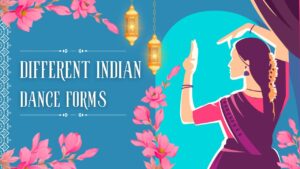Different Indian Dance Forms

Different Indian Dance Forms
The document you’ve uploaded provides a detailed account of various Indian dance forms, both classical and folk. Here’s a summary of the key information from the document:
1. Indian Classical Dance Forms:
India is home to a rich tradition of classical dance forms, each with its own distinctive style and cultural background. The document mentions the following classical dance forms:
- Bharatanatyam: Originating from Tamil Nadu, this dance form is well-known for its expressive movements and musical beats. The dancers wear traditional sarees and perform with live musical accompaniment, focusing on hand gestures (mudras) that carry great significance.
- Kathak: Rooted in the storytelling traditions of northern India, particularly Uttar Pradesh, Kathak is characterized by intricate footwork and fast-paced spins. The dance begins slowly and gradually builds speed. Dancers wear ankle bells (ghungroos) to enhance the foot movements.
- Kuchipudi: This dance form hails from Andhra Pradesh and is known for its elaborate performances, which often depict stories from Hindu mythology, particularly the life of Lord Krishna. A unique aspect of Kuchipudi is the performer dancing on a brass plate.
- Odissi: Originating from Odisha, this dance form is primarily based on the stories of Lord Krishna, similar to Bharatanatyam, with graceful movements.
- Kathakali: A traditional dance form from Kerala, it typically narrates stories from the Ramayana and Mahabharata. The dancers wear elaborate makeup and costumes and express emotions through facial expressions, without speaking.
- Sattriya: From Assam, this dance form was developed by the saint Sankardeva 500 years ago. It was initially performed by monks, but now women also participate.
- Manipuri: This dance form from Manipur revolves around the theme of Lord Krishna and Radha’s Raas Leela. It is known for its delicate movements and distinct costumes, such as drum-shaped skirts.
- Mohiniyattam: Originating in Kerala, this is the only classical dance exclusively performed by women. It blends elements of Bharatanatyam and Kathakali.
2. Indian Folk Dance Forms:
Folk dances are generally simpler and reflect the local traditions, often performed to mark festivals and celebrations. Some notable folk dances from different parts of India are:
- Raas Leela (Uttar Pradesh): Associated with the stories of Krishna, particularly his interactions with the gopis (cowherd girls), this dance form is performed during festivals like Janmashtami.
- Garba (Gujarat): A popular dance performed during Navaratri to honor Goddess Durga, typically performed in a circle with rhythmic steps.
- Ghoomar (Rajasthan): This vibrant dance is performed by women wearing traditional ghagras (long skirts) to honor Goddess Saraswati. It’s a visually captivating dance with swirling movements.
- Bihu (Assam): A fast-paced, energetic dance performed during the harvest festival of Bihu in Assam, accompanied by the beats of traditional drums.
- Lavani (Maharashtra): Performed to the beats of the dholki (drum), this is a lively dance performed primarily by women, known for its bold moves and engaging rhythms.
- Matki (Madhya Pradesh): In this dance, women balance pots on their heads while performing intricate movements.
- Bhangra (Punjab): Perhaps the most globally recognized Indian folk dance, Bhangra was traditionally performed during the harvest season but is now a symbol of celebration across the world.
- Rauf (Jammu & Kashmir): A traditional dance performed by women during festivals, characterized by simple foot movements and performed in two lines.
Each of these dance forms holds a special place in Indian culture, representing the diversity of the country’s artistic heritage. The classical dance forms, in particular, require years of rigorous training, while folk dances are more community-oriented and spontaneous.
Key Dance Artists:
The document also highlights several renowned artists who have significantly contributed to preserving and promoting Indian classical dance forms. Some notable artists include:
- Bharatanatyam:
- Yamini Krishnamurthy: A highly respected Bharatanatyam dancer known for her classical technique and grace.
- Rukmini Devi Arundel: A pioneer in reviving Bharatanatyam in the 20th century, founded the prestigious Kalakshetra institution.
- Padma Subrahmanyam: Known for blending dance with scholarship, she is celebrated for her innovations in Bharatanatyam.
- Mohiniyattam:
- Bharati Shivaji: A prominent exponent of Mohiniyattam, known for her devotion to promoting and preserving this art form.
- Jayaprabha Menon: A leading Mohiniyattam dancer and choreographer known for her expressive performances.
- Kathak:
- Birju Maharaj: A legendary figure in Kathak, known for his mastery of rhythm, storytelling, and expression.
- Sitara Devi: A renowned Kathak artist known for her powerful performances and contributions to popularizing the dance form worldwide.
- Odissi:
- Kelucharan Mohapatra: One of the most influential figures in the revival of Odissi, known for his dedication to the art.
- Sonal Mansingh: A celebrated Odissi dancer and cultural icon, who has received numerous accolades for her contribution to Indian classical dance.
- Kuchipudi:
- Vedaantam Satyanarayana Sharma: A prominent figure in Kuchipudi, known for his dedication to traditional themes.
- Raja and Radha Reddy: Renowned Kuchipudi dancers who have been instrumental in popularizing the dance form internationally.
- Kathakali:
- Kalamandalam Gopi: One of the most celebrated Kathakali performers, known for his mastery of facial expressions and dramatic storytelling.
- Krishna Nair: A major figure in the evolution of Kathakali, instrumental in its continued relevance.
Conclusion:
India’s classical and folk dances reflect the country’s diverse cultural heritage, offering a deep insight into its history, spirituality, and traditions. While classical dances like Bharatanatyam, Kathak, Kuchipudi, and others require years of rigorous training and discipline, folk dances are spontaneous, lively expressions of joy and community bonding. Both forms have sustained their relevance in contemporary society, connecting modern audiences with ancient traditions and showcasing the timeless beauty of Indian art.
Also, Visit:
RRB and Other Pharmacist Exams Previous Year Solved Paper
